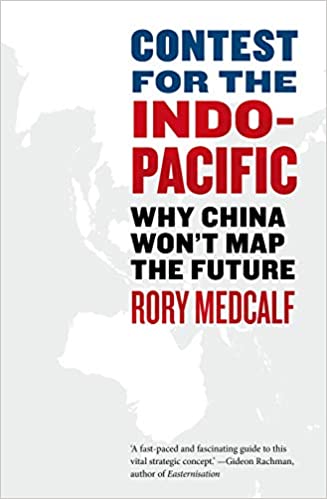Contest for the Indo-Pacific: Why China Won’t Map the Future
Rory Medcalf
2 December 2020In Search of Order
Christian Wagner
Contest for the Indo-Pacific:
Why China Won’t Map the Future
By Rory Medcalf
La Trobe University Press Australia, 2020
The Indo-Pacific has emerged as the new geopolitical theatre of the 21st century. The future contest in this “global region” (p. 169) is often perceived with a focus on the rivalry between the United States (US) and China.
The big question is which model will be best-suited to achieve stability in the Indo-Pacific? Will it indeed be the great power rivalry with ideological blocs behind the G-2, which are China and the US? Will the Association of Southeast Asian Nations centrality be the core of a new institutional network? Will it be a concert of mini-lateralism, consisting of the middle powers in the region and like-minded outside powers from Europe such as France, the United Kingdom and Germany?
With practical experience as a former intelligence analyst and now as professor at the Australian National University, Rory Medcalf offers his readers both a broad historical perspective and specific recommendations for policy makers. His purpose is twofold: to make sense of the historical, political, economic and military developments in the region, which is home to about 30 per cent of the global population, and to analyse how the region can cope with an increasingly assertive China (p. 3).
Medcalf’s excellent volume enriches the ongoing debate with at least two dimensions: first, by highlighting the role of middle powers like India, Japan, Australia, Indonesia, South Korea and others that have been mostly neglected in previous works for the future development of the Indo-Pacific. Secondly, he points out the importance of narratives in the future contestation.
In contrast to the region conceptualised as “Asia-Pacific”, which symbolised the success of economic globalisation and the rise of the Asian Tigers, the notion of the “Indo-Pacific” reflects a geostrategic setting in which dragons, elephants and other big players dominate the scene. The crux of the Indo-Pacific concept is that even like-minded countries like the US, Japan, India and Australia have different ideas of the geography of this region and about China’s role. Although China has opposed the idea of an Indo-Pacific from the beginning, the debate is characterised by the “irony” (p. 4) that the concept only gained a larger importance because of China’s actions in the contested region.
Medcalf identifies four main areas where the confrontation over the Indo-Pacific will take place: economics, military force, diplomacy and a clash of national narratives. The importance of the region for the global economy is well-known and documented. The growing power projection of China, India and Japan along with military modernisation has for many years also been part of the ongoing competition.
One of the main merits of Medcalf’s book is to highlight the importance of narratives for the future contestation. The Indo-Pacific has evolved as a counter-narrative against China’s regional and global ambitions. Broadening the spectrum to include narratives also underlines the peculiarity of the Indo-Pacific, where classical strategies of hegemony and spheres of influence will not work. Soft power strategies have become important instruments in foreign policy not only for China but also for India and Japan in recent years. Part of this race for legitimacy is that it affects domestic debates especially in open societies like Australia, where China’s influence on national politics has created new controversies.
Another main achievement of Medcalf’s book lies in its optimistic subtitle Why China Won’t Map the Future. In contrast to many other contributions, he sees an important role for the middle powers in the future development of the Indo-Pacific.
The most difficult challenge is the evolution of a common strategy among the middle powers in order to cope with China’s ambitions. Medcalf opts for a multi-faceted strategy with “multipolarity, solidarity … and strategic patience” as watchwords (p. 268). The growing number of tri- and mini-lateral arrangements that have developed in recent years is a promising strategy for him. He recommends that these formats be opened for like-minded “outside” powers which also have an interest in securing stability in this global region.
The maritime dimension of the Indo-Pacific is probably a bigger problem for the middle powers than for China, whose Belt and Road Initiative consists of maritime and land-based projects. Maritime spaces are difficult focal points for closer regional cooperation among middle powers, although a perceived common external threat has always been a good stimulus for closer collaboration.
Moreover, in contrast to great powers like the US and China, which may have long-term geostrategic interests, the situation is not so clear with regard to middle powers. Their strategic outlook may be more prone to changing domestic priorities.
So, the main task will be how to establish solidarity among the middle powers in the long-term perspective. This may require expansion of the cooperation from the diplomatic and military field to segments of society in order to broaden the common narrative among middle powers. Otherwise, the Indo-Pacific may remain a strategic theatre rather than a lived reality for its people.
Medcalf’s very valuable achievement here is to go beyond the classical great power rivalry debate and bring into focus the variety of players which will contribute to the stability of the global region named Indo-Pacific.
. . . . .
Dr Christian Wagner is a Visiting Senior Research Fellow at the Institute of South Asian Studies (ISAS), an autonomous research institute at the National University of Singapore (NUS). He is also a Senior Fellow at the German Institute for International and Security Affairs in Berlin. He can be contacted at christian.wagner@swp-berlin.org. The author bears full responsibility for the facts cited and opinions expressed in this paper.
-
 More From :
More From :
-
 Tags :
Tags :
-
 Download PDF
Download PDF



